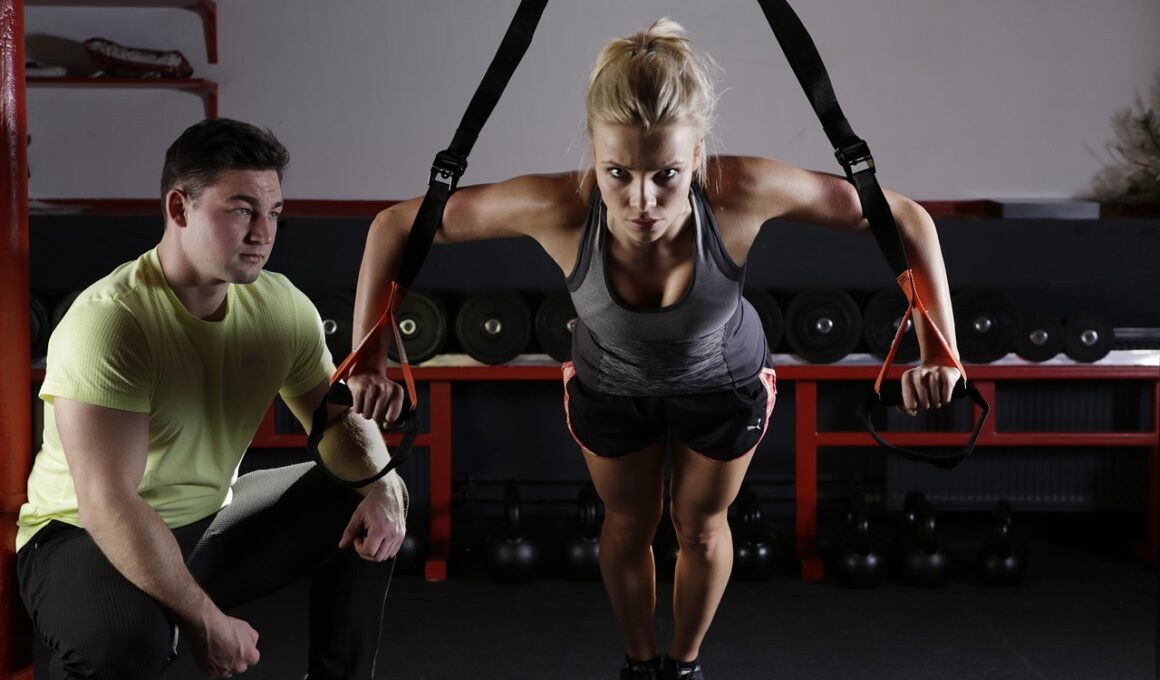Injury Prevention Tips for Women Lifting Weights
When engaging in weight lifting, injury prevention should be a priority for women of all fitness levels. Understanding proper lifting techniques is essential in avoiding injuries. Start with lighter weights to master your form before gradually increasing the weight. Ensuring proper alignment of the body during exercises can prevent undue strain on muscles and joints. Additionally, warming up properly before lifting weights is crucial. Dynamic stretches and light cardio can prepare your muscles for more intense activity, reducing the risk of injury significantly. Include exercises that strengthen stabilizing muscles, such as the core, to provide better support during your workouts. Furthermore, listen to your body and rest if you experience any discomfort during your workout. Ignoring pain can lead to more serious injuries in the long run. Regularly incorporating rest days into your routine is also necessary to ensure proper muscle recovery. Hydration is another key factor in injury prevention; always keep your body adequately hydrated. Lastly, consider consulting with a certified trainer who can guide you in developing a personalized lifting program that minimizes injury risk, especially when starting out or trying new exercises.
Another important aspect of injury prevention is selecting the right equipment. Proper footwear is essential, as shoes designed for weightlifting provide the necessary support and stability. Make sure to also use appropriate weightlifting gear, such as belts and wrist wraps, when needed. These can help maintain your form and prevent excessive strain on your body. Stay consistent with your training to enhance strength and technique over time. However, never shy away from asking for help or corrective feedback. We all have blind spots, and referring to experienced lifters or professionals can be enlightening. Ensure you are also practicing balance in your workout routine by incorporating various exercises that target different muscle groups. This approach reduces overuse injuries and helps in building a well-rounded physique. Consider integrating flexibility and mobility training into your regimen. Stretching regularly not only enhances muscle elasticity but also prepares those muscles for future lifts. Furthermore, maintain a focus on nutrition that promotes muscle recovery. Post-workout meals rich in proteins can aid in rebuilding muscle tissues that might have been strained during lifting, effectively reducing the likelihood of injury.
Listen to Your Body
One crucial tip in injury prevention is to always listen to your body signals. Pushing through pain can lead to chronic issues and even significant injuries. Recognize the difference between discomfort from exertion and pain that signals a potential injury. If you are feeling tired or sore, it might be time to modify your workout or take a rest day. Regular self-assessment during exercise can help determine your limits and capabilities. Creating a balanced training schedule allows time for recovery, ensuring that your body doesn’t feel overwhelmed. Moreover, implementing foam rolling or myofascial release techniques can help alleviate muscle tightness post-workout. This practice ensures better muscle function by increasing blood flow and enhancing recovery velocity. As you progress in your lifting routine, reassess your goals and adjust exercises as necessary. Remember that fitness is a journey; there is no rush to lift heavier weights. Focus on improvement, not just intensity, to promote a sustainable and injury-free fitness journey.
Having a partner in your weight lifting journey can also contribute positively to injury prevention. Spotting each other while lifting can help catch any potential mishaps. A partner can provide motivation and assistance in maintaining proper form. If you’re lifting extremely heavy weights, having someone ensure your safety can be a lifesaver. Encourage each other to remain mindful of technique, focus on gradual improvements, and respect your bodies. Consistency is crucial, but safety must come first. Also, consider varying your lifting routine with cross-training. Engaging in different fitness modalities such as yoga, Pilates, or swimming can improve overall flexibility and strength while reducing injury risks. These activities tend to provide strength benefits by alleviating stress from habitual workouts. They allow for recovery and restoration of weary muscles, creating a well-rounded regimen. Monitor your progress regularly to ascertain what works for you and what doesn’t. Tracking workouts can help identify patterns of fatigue or discomfort before they translate into injuries. Keeping a journal or using apps can be beneficial in this respect for continuous improvement.
Consulting Professionals
A highly effective injury prevention strategy is to seek guidance from professionals, especially for those new to weight lifting. Personal trainers can provide personalized workout regimens based on individual goals and physical capabilities. This ensures that exercises are tailored specifically for you and any existing health concerns are considered. Moreover, physical therapists can help you recover from previous injuries and ensure that you engage in safe workouts. They often recommend specific exercises to strengthen areas that are prone to injuries, enhancing overall performance. Attending classes led by certified instructors is another beneficial option. These classes emphasize correct techniques in a supportive environment, which significantly reduces injury risks. It’s also wise to invest time into learning about your body’s biomechanics. Understanding how your muscles and joints interact during exercise can further prevent injuries resulting from improper techniques. Educating yourself about lifting frameworks and best practices is an invaluable aspect of a successful journey in muscle building for women. Keeping yourself updated with the latest research and trends in weight lifting can lead you toward safer practices and mitigating injury risks.
Finally, don’t forget to incorporate mental strength into your physical training. Building mental resilience can help overcome challenges and maintain focus during workouts. Visualization techniques can be powerfully motivating and can help prepare your body for lifting sessions. When your mind is strong, it enables you to listen to its signals more effectively. This awareness can alert you if something feels off during your workouts. Additionally, practicing mindfulness or relaxation techniques such as meditation can improve focus and reduce stress. High-stress levels can create tension in your body, possibly leading to injuries as you lift. Make sure to prioritize sleep too; adequate rest is crucial for recovery and overall wellness. A well-rested body is less prone to injury. Aim for a holistic approach that combines physical, mental, and nutritional elements to establish a robust foundation in your fitness journey. Embrace the complexity of developing a sustainable fitness regimen that values safety as much as progress. Ultimately, prevention, knowledge, and self-care all play significant roles in avoiding injuries while achieving your strength building goals.
Conclusion
In summary, injury prevention is an integral aspect of weight lifting for women. By implementing these tips into your routine, you can create a safer lifting environment. Always remember to start with lighter weights, prioritize proper technique, and continually assess your body. Additionally, utilizing correct equipment and working with professionals can enhance safety in your workouts. Regular rest and recovery, combined with a focus on nutrition, deliver the foundation for sustaining your fitness journey. Consult your body throughout the process, and embrace the practice of listening to its signals. A supportive lifting partner can make the experience enjoyable while ensuring safety too. Finally, attention to the mental aspect of fitness and educational resources can ensure a more substantial understanding of safe lifting practices. By now, you should feel empowered to lift weights while being vigilant in injury prevention. Utilizing all these strategies is the key to enjoying your fitness journey without compromising your health. Begin applying these recommendations today and embrace your strength. Your journey towards effective muscle building starts now, equipped with the tools for injury prevention.
Lastly, empowering women in fitness is essential to fostering a community that encourages healthy lifting practices. Sharing experiences and learning from one another enhances our collective understanding of injury prevention techniques. Together, we can create a supportive network that prioritizes safety and promotes resilience in each other. Women lifting weights should not only appreciate their physical abilities but also recognize the importance of mental well-being in their workouts. Engaging in_open conversations about challenges faced while lifting creates an open avenue for discussions around safety and injury awareness. Let’s commit to sharing knowledge and supporting each other on this fitness journey. As women, we can set an example through our dedication to responsible weight lifting practices. Additionally, finding motivation in uplifting narratives can drive positive changes in our training approaches. Remember, your fitness journey is unique, and embracing each step is part of the process. By implementing the mentioned strategies, you will not only enhance your lifting experience but also ensure long-lasting benefits on your fitness path. Embrace your progress, stay motivated, and inspire responsible lifting in your community. Let us rise together!


